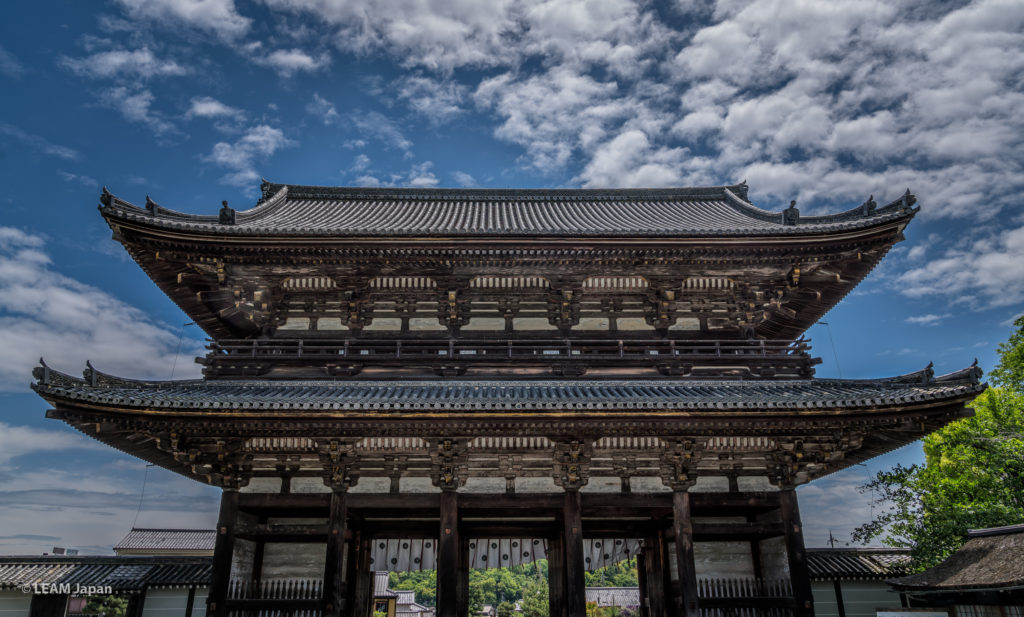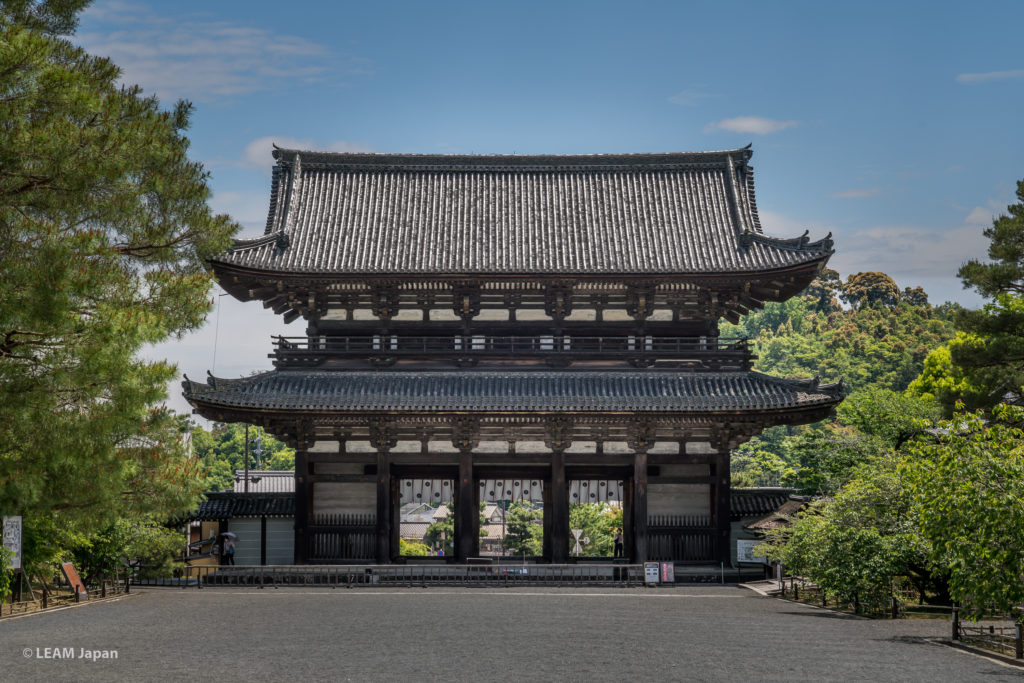【日本の観光】京都 世界遺産 真言宗総本山仁和寺

<仁和寺の伽藍>
仁和寺は第58代の光孝天皇が発願し、次の59代の宇多天皇の仁和4年(888年)に完成しました。
最初は「西山御願寺」と呼ばれていましたが、仁和の年号から「仁和寺」と呼ばれるようになりました。
宇多天皇は在位11年で醍醐天皇に譲位し、仁和寺に入ったといわれています。
延喜4年(904年)には宇多法皇は御所を仁和寺に営まれました。元々「室」とは僧坊のことを指し、尊称して御室と呼ばれていました。
最初は御所の建物を指していましたが、やがて仁和寺の門跡の呼称になり、さらには近辺の地名ともなりました。
このような歴史により、仁和寺では光孝天皇を「本願天皇」と呼び、宇多天皇を「宇多法皇」または「開山法皇」と呼んでいます。
また宇多法皇は「寛平法皇」とも呼ばれることがあります。これは醍醐天皇が先帝の退位に際し「太上天皇」という称号を奉ったが、固辞されたため、その年号の「寛平」をとってこのように呼ぶようになったと伝えられています。
仁和寺の創建当初の様子は詳しく分かっていませんが、現在の境内には「八角円堂」という建物の遺構が発掘されており、当時の金堂もほぼ現在の位置にあったと考えられています。
仁和寺が創建当初から現在のような大きな寺院だったかどうかは議論があります。いずれにせよ、創建当時の仁和寺は御室が長保3年(1001年)、金堂が元永2年(219年)に焼失したことが記録されていますが、その後も徐々に大きな寺になっていったと考えられています。
ところが、応仁の乱の際に仁和寺は一夜にして全てを失ってしまいました。応仁2年9月4日、仁和寺は西軍の拠点となっていたため、東軍による焼打ちに遭い、金堂、御室、円堂院など数百の建物が全て灰燈に帰しました。
その後、仁和寺は双ケ丘の西方に仮の御所を建て、約150年間ここで暮らすことになりました。
仁和寺の第21世、覚深法親王は、仁和寺の御所跡地が「本地野」と呼ばれ、草が茂る光景を悲しみ、仁和寺の再興を発願しました。徳川幕府から建設資金を得て、紫震殿などの建物を下賜され、それによって現在の仁和寺が再興されました。
この時の建物の一部は明治20年の大火で焼失しましたが、明治末から大正初期にかけて再建され、現在の姿に復元されました。
多くの建物は国宝や重要文化財に指定され、境内は「史跡」や「名勝」に指定されています
Ninna-ji Temple was initiated by the 58th Emperor Koko and completed in the 4th year of the Ninna Era (888) by the next 59th Emperor Uda. Initially called ‘Nishiyama Goganji’, the temple came to be known as ‘Ninna-ji’ after the year Ninna. Emperor Uda is said to have abdicated to Emperor Daigo after 11 years on the throne and entered Ninna-ji. In 904 (Engi 4), Emperor Uda established his Imperial Palace at Ninna-ji Temple. Originally, ‘muro’ referred to the monks’ quarters, which were respectfully called Omuro. At first it referred to the buildings of the Imperial Palace, but eventually it became the name of the Ninna-ji monastery, and even the name of a nearby place. Due to this history, Emperor Koko is referred to at Ninna-ji as ‘Hongan-tennō’ and Emperor Uda as ‘Uda-hōhō’ or ‘Kaisan-hōhō’. Emperor Uda is also sometimes referred to as ‘Kanpei Hōhō Emperor’. It is said that Emperor Daigo offered him the title of ‘Emperor Taisho’ when his predecessor abdicated, but he was adamant about it, so he took the name ‘Kanpei’ from the year of his abdication. The details of the early days of Ninna-ji Temple are not known, but the remains of a building called the Octagonal Round Hall have been excavated in the present precincts, and it is thought that the Kondo Hall of that time was also located in approximately the present position. There is some debate as to whether Ninna-ji Temple was as large as it is today from the time of its foundation. In any case, it is recorded that Ninna-ji Temple at the time of its foundation was destroyed by fire in the 3rd year of Chōho (1001) for the Omuro and in the 2nd year of Gen’ei (219) for the Kondo, but it is thought that the temple gradually became larger thereafter. However, during the Onin War, Ninna-ji Temple lost everything overnight. On 4 September 2, Ninna-ji was a stronghold of the Western Army and was burnt to the ground by the Eastern Army, with hundreds of buildings, including Kondo, Omuro and Endoin, all reduced to ashes. Ninna-ji then built a temporary palace on the western side of Soukaoka, where it lived for about 150 years. The 21st head of Ninna-ji, His Holiness Kakushin, was saddened by the sight of the former site of the Ninna-ji Palace, known as ‘Honjino’ and overgrown with grass, and vowed to rebuild Ninna-ji. He received construction funds from the Tokugawa Shogunate and was given buildings such as the Shishinden, which led to the present-day Ninna-ji being reconstructed. Some of the buildings from this time were destroyed by fire in the Great Fire of 1887, but were rebuilt from the end of the Meiji period to the early Taisho period and restored to their present appearance. Many of the buildings have been designated as national treasures or important cultural assets, and the precincts have been designated as ‘historic sites’ or ‘scenic spots’.

仁王門とは?
京都観光にお勧め、世界遺産 真言宗御室派総本山 仁和寺を訪れる人は、最初にこの二王門を目にします。この建物は堂々とした雰囲気があり、道路から一段高い位置に建てられているため、さらに雄大さを感じることができます。「二王門」という名前の由来は、ここには寺全体を守護する二王像が収められているからです。一般的には「山門」とも「南大門」とも呼ばれています。この二王門は、知恩院の三門や南禅寺の山門と一緒に、京都の三大門として知られています。ただし、知恩院や南禅寺の門は禅宗様式、つまり唐様で建てられているのに対し、仁和寺の二王門は和様で作られています。そのため、より穏やかな雰囲気を持ち、大きな建物でありながら、明るく上品な印象を与えます。この二王門は、江戸時代の寛永十四年から正保三年にかけて建てられました。
Visitors to Ninna-ji Temple will first see the Nioimon Gate. It has an imposing appearance and is built one level higher than the road, giving it an even more majestic appearance. The name ‘Nioimon’ comes from the fact that it houses the two guardian statues of the temple as a whole. It is also commonly referred to as ‘Yamamon’ or ‘Nandaimon’. Together with the Sanmon Gate of Chion-in Temple and the Sanmon Gate of Nanzenji Temple, this Nioimon is known as one of the three main gates of Kyoto. However, while the gates of Chion-in and Nanzen-ji are built in the Zen Buddhist style, i.e. in the Chinese style, Ninna-ji’s Nioimon is built in the Japanese style. This gives it a more peaceful atmosphere and, despite being a large building, it has a bright, elegant appearance. The Nioimon was built between Kan’ei 14 and Shoho 3 in the Edo period.
TRIP PHOTO コンシェルジュサービス
LEAM Japanは、日本全国の世界自然遺産や国宝、重要文化財など、日本が誇る自然や歴史的価値のあるスポットなど、連携している歴史的価値ある場所と、日本の伝統工芸など本物を知り、体験していただくための富裕層むけプランニングを行っています。お客様の興味に合わせ、オンリーワンに拘り、文化体験やお食事、非公開エリアのプライベートツアー、記念撮影サービスなどを展開しております。
京都仁和寺では、TRIP PHOTOでお申込みいただきましたお客様は、国宝、重要文化財の非公開エリアを僧侶の解説つきで行うツアーや能楽、雅楽など日本の伝統芸能鑑賞を楽しみながらのお食事など、まるでタイムスリップしたような体験をプロデュース致します。
LEAM Japan provides planning services for affluent customers to learn about and experience the real thing, such as traditional Japanese crafts, and places of historical value, such as World Natural Heritage sites, national treasures and important cultural assets throughout Japan, and other places of historical value in collaboration with Japan’s proud natural and historical sites. We offer cultural experiences, dining, private tours of undisclosed areas, commemorative photo services, etc., tailored to the interests of our clients and focused on the one-of-a-kind.
At Ninna-ji Temple in Kyoto, customers who apply through TRIP PHOTO can enjoy a tour of the National Treasure and Important Cultural Property with a priest’s commentary in an undisclosed area, or enjoy a meal while watching traditional Japanese performing arts such as Noh and Gagaku, producing an experience that is like stepping back in time.

【企画プロデュース】 LEAM Japan Mariko Kitamura 日本の伝統文化・伝統工芸、国宝、重要文化財などの日本の「ホンモノ」をインバウンドVIP向け観光資源にするプランニングを提案、独自サービス「TRIP PHOTO」を手掛け地方創生のビジネスモデルとなるサービスを作成し、世界へPRするスキームを構築中。 愛媛県・松山まつり「野球拳おどり2023」キービジュアルのアートディレクションを手掛けています。 フォトグラファーとしてファッション・モデル・アーティストの撮影、創作ストーリー撮影を得意とし、プロデューサー兼アートフォトグラファーとしてオールラウンドに活躍。

